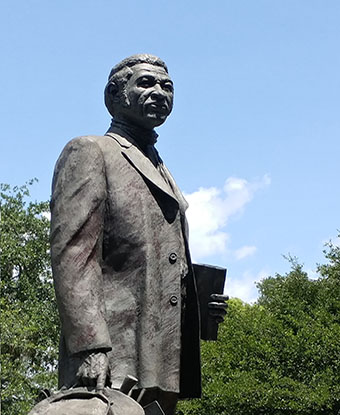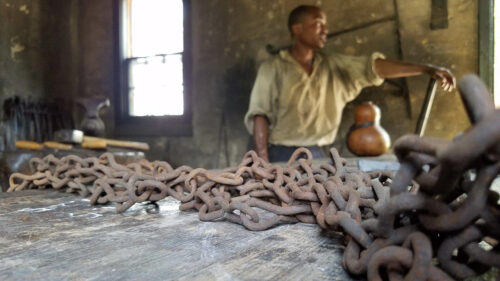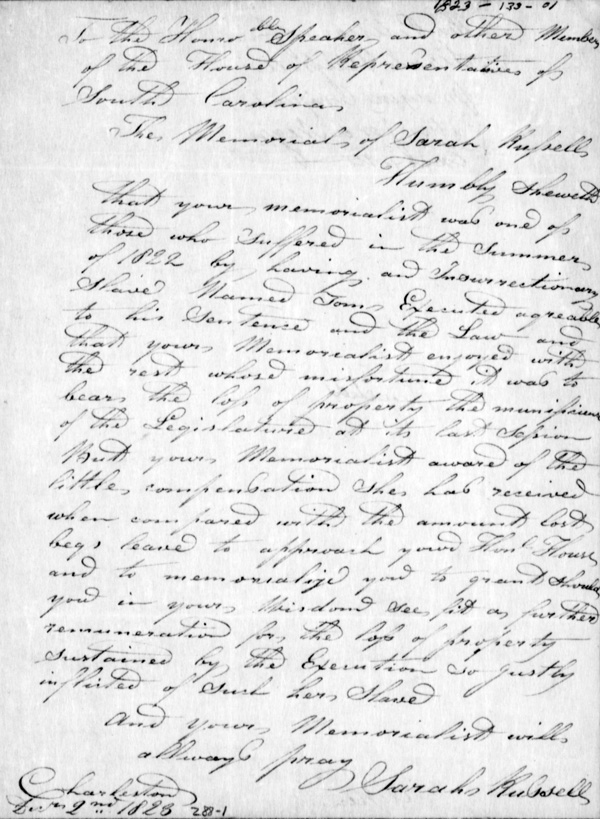 Menu
Menu
Posted: June 27, 2023

Statue of Denmark Vesey
The Denmark Vesey rebellion, and the subsequent trial of co-conspirators, has been a subject of study for historians for quite some time. Most recently, the focus has been on Vesey’s motivations, civil rights actions, and the pursuance of liberty and justice for all through violence. Of further interest has been the relationship of religion, and the use of scripture to justify action, in assessing the failed plot. No matter the lens through which one looks, the Vesey revolt certainly echoes into the modern era most poignantly through the simple stories of the men involved. Stories that are gleaned through trial testimonies, and circumstantial research, paint rich and individual portraits of men who exercised their agency within the confines of enslavement – choosing a path that was high risk, and potentially (although we know now, unrealized) high reward.
One such man was Tom Russell; often a footnote in the histories of the rebellion, at least his name and deeds are generally known by Vesey scholars. Russell was considered the “armorer of the rebellion”, though in truth many enslaved skilled artisans agreed to join[1]; Tom was said to have made six pikes to serve as weapons for the uprising.

Jamal Hall, a living historian, representing an enslaved blacksmith at Middleton Place. Tom Russell was considered the armorer of the Vesey Rebellion.
Some of Tom’s fellow prisoners testified that they saw the edged weapons in person, some that they had only heard about them. Many who testified against Tom certainly included his blacksmithing assignment as weapons-maker in their depositions.[2] Upon closer inspection, however, Tom is potentially much more than simply a talented blacksmith lending his skill to a cause.
The truth of Tom Russell’s enslavement is shrouded in some mystery. Various researchers at Historic Charleston Foundation have investigated exactly which Russell family in Charleston enslaved Tom. By the Rebellion of 1822, Nathaniel Russell had died, and Sarah Hopton Russell was a widow. In the Charleston City Directory of 1822, there are at least four Sarah Russells – at least two of them widowed.[3] This means that the enslaver who would have been notified of Tom’s arrest and trial, would have been Sarah Russell – but which one? Several efforts have been made by Historic Charleston Foundation staff over the years to either prove or disprove that Sarah Hopton Russell was Tom Russell’s enslaver.[4]
The short answer is that we can neither prove nor disprove it. There is plenty of circumstantial evidence that would suggest that it was Sarah Hopton Russell who owned Tom at the time of the rebellion, but there is also some circumstantial evidence that it was a different Sarah – the widow of a blacksmith and edged tool maker, John Russell. The John and Sarah Russell family lived in Wentworth Street, close to the home that Denmark Vesey lived in, and nearby to other conspiracy activities.[5] John also had a blacksmith shop in East Bay Street (where Tom Russell was also said to have kept a shop). Coupling this information with the fact that John Russell was a blacksmith starts to create a very viable scenario in which they are Tom’s enslavers. Additionally, testimony was given against Tom by a Mrs. Mark Marks – the wife of a deputy sheriff of Charleston, who lived in the same neighborhood, and who likely occupied a similar socioeconomic status as the John Russell family – middling citizens, comfortable enough own a few enslaved people.[6]
However, the John Russell family did not always own enslaved people – in earlier Charleston City Directories, they are listed without enslaved property.[7] Additionally, he advertised in the newspaper in earlier decades to hire enslaved help via the uniquely Charleston hire-out system that featured enslavers essentially renting out their enslaved artisans workers to those seeking additional help either in their occupations or in their households.[8] If John Russell was not wealthy enough to own enslaved people, then it is a further leap to suggest that among the four enslaved people his family came to own was a likely very skilled, and therefore very expensive, educated metalworker like Tom Russell.
In contrast to the John Russell family, the Russell family of 51 Meeting Street had many enslaved people living and working both at their home, and likely at Nathaniel Russell’s various shops and wharf. Additionally, their status as prominent citizens in Charleston might have influenced the way in which Sarah Hopton Russell experienced the rebellion and trial as a widow. For example, one of the reasons the identity of Tom Russell’s enslaver is still unknown, even though we know her name, is because neither Sarah appeared in court for Tom Russell’s trial. Rather, a lawyer who was a personal friend of the widow Russell attended on her behalf. James Gray, Esq, who in 1822 lived across Meeting Street from the Nathaniel Russell House was in attendance for Tom’s enslaver.[9] He cross-examined witnesses, acting as Tom’s lawyer, and he agreed to have Mrs. Marks’ testimony admitted without sending for Mrs. Russell to confirm it.[10]
James Gray’s proximity to the Nathaniel Russell House is an important piece of this historical puzzle, which has thus far fallen through the cracks; if he lives in Meeting Street near Sarah Hopton Russell, it is likely that as a lawyer and resident of Meeting Street he shares a socioeconomic status and a social circle much more akin to Sarah Hopton Russell than Sarah, John Russell’s widow. Additionally, he would have been expensive to hire as counsel for Tom’s enslaver (and by extension, for Tom himself). It is questionable whether the widow of a blacksmith would have had the funds to hire him, whereas not only would Sarah Russell have had the funds, she might have had a personal, neighborly relationship with him that might have reduced or eliminated her fees entirely.
Interestingly, there is also a known connection between Denmark Vesey’s enslaver (before Vesey purchased his own freedom) and whose surname – Vesey – Denmark retained for the remainder of his life and Nathaniel Russell, that stretched back to the 18th century. Russell and Captain Joseph Vesey knew each other, and created a philanthropic society together in 1793, to aid refugees from the Haitian Revolution – a successful insurrection of freedom-seeking enslaved in Saint-Domingue.[11] As you can imagine, this refugee aid was likely for enslavers forced to flee their homes to start again in Carolina. In any case, Russell and Vesey’s long acquaintance hints to a similarly lengthy familiarity between Denmark and Tom. If they were both enslaved at the same time to the merchant and the sea captain, then Tom would have been a natural choice for Vesey, when considering who might be interested in fomenting rebellion. Vesey often referenced the insurrection in Saint Domingue and may have even had one of his lieutenants write a petition for the Haitian’s help in his own rebellion.[12] If Tom and Denmark had known each other for upwards of thirty years, Tom remaining in bondage to Nathaniel Russell’s family, then perhaps a larger role for Tom in the insurrection beyond armorer becomes more possible. This also discounts the idea that John Russell would have taught Tom his trade – the enslavement to the John Russell family would have only lasted a few short years – not nearly enough years of training or experience to confer a master-status ability of smithing to Tom.

A scan of Sarah Russell’s petition.
Finally, after Tom’s conviction and execution – indeed almost all of the co-conspirators were found guilty and with a few exceptions, convicted to death – Sarah Russell petitioned the South Carolina House of Representatives for additional payment. She wrote (left) that though she did receive some compensation for the loss of her enslaved property, that she felt she was owed more.[13] The House took up her request and after consideration declined issuing any further payment.[14] One wonders if this was Sarah Hopton Russell, who had honed her taste for litigation over her years of marriage. Nathaniel Russell was known to be litigious – often taking clients or associates to court to recover debts owed to him; he even had cases heard by the Supreme Court. It would make sense that Sarah Hopton Russell would have both the mindset and the connections to pursue such a similar avenue, asking for further recompense, after watching her husband navigating litigations throughout his career.
After considering every angle, and following every available piece of evidence, there is still no “smoking gun” that points to Sarah Hopton Russell over Sarah Russell of Wentworth Street being Tom’s enslaver. However, with emerging documentary research and circumstances in her favor, it seems that Sarah Hopton remains the more viable candidate. Until such time as Sarah Hopton Russell’s participation in this saga is fully proven impossible, it is imperative that Historic Charleston Foundation interpret Tom’s story. The house on Wentworth Street, if it is even the same house as was lived in by the 1820s Russell family of blacksmiths, is not a historic site, nor is any other site in Charleston exploring the supporting characters and other players in this monumental act of resistance. As an organization that strives for best practices in interpreting all aspects of history as they happened here in Charleston, we are dedicated to bringing the stories of the underrepresented – the enslaved especially – to light, and it is for this reason that Tom Russell should be a regular part of the ongoing dialogue at the Nathaniel Russell House.
-Carin Bloom, Manager of Education & Programming. Historic Charleston Foundation, June 19, 2023
Footnotes and sources:
[1] Thomas Wentworth Higginson, “Denmark Vesey”, The Atlantic, June, 1861, 733.
[2] Lionel H. Kennedy & Thomas Parker, “An Official Report of the trials of sundry Negros, charged with an attempt to raise an insurrection”, (Charleston: James R. Schenck, 1822) https://tile.loc.gov/storage-services/service/rbc/rbcmisc/lst/lst0101/lst0101.pdf.
[3] James W. Hagy, Charleston, South Carolina City Directories for the Years 1816, 1819, 1822, 1825, and 1829 (Baltimore, MD.: Clearfield, 1996), 97.
[4] “Tom Russell”, internal HCF documentation, HCF Intern, August 2, 2016.
[5] Hagy, City Directories.
[6] Kennedy & Parker, Official Report, 91.
[7] Hagy, City Directories.
[8] John Russell, “Blacksmith & Edge Tool Maker”, South Carolina State Gazette and Timothy’s Daily Advertiser, March 20, 1802.
[9] Kennedy & Parker, Official Report, 89.
[10] Ibid, 90-91.
[11] Douglas R. Edergton & Robert L. Paquette (editors), The Denmark Vesey Affair: A Documentary History, (Gainesville: University Press of Florida, 2022), 209, footnote 1.
[12] Some sources say Monday Gell confessed to this deed (Higginson, “Denmark Vesey”) but the veracity of this statement is unclear (Kennedy & Parker, Official Report).
[13] Sarah Hopton Russell, “To the Honorable Speaker and other Members of the House of Representatives of South Carolina”, The Memorial of Sarah Hopton Russell, 1823, South Carolina Department of Archives and History document scan.
[14] Committee of Claims, “Report of the Committee of Claims on the petition of Sarah Russell”, 1823, South Carolina Department of Archives and History document scan.
Images (in order of appearance):
Denmark Vesey Monument in Hampton Park, Charleston, South Carolina.
Living historian, Jamal Hall, representing an enslaved African American blacksmith at Middleton Place. Tom Russell was considered the armorer of the Vesey Rebellion. (Also used in header image and feature image)
Historic American Buildings Survey, Creator, et al., photographers by Greene, C O, and Charles N Bayless. Nathaniel Russell House, 51 Meeting Street, Charleston, Charleston County, SC. trans by Mcpartland, Marymitter Documentation Compiled After. Photograph. Retrieved from the Library of Congress www.loc.gov/item/sc0171/.
Scan of archival document. Sarah Hopton Russell, “To the Honorable Speaker and other Members of the House of Representatives of South Carolina”, The Memorial of Sarah Hopton Russell, 1823, South Carolina Department of Archives and History document scan.
Thank you for this fine research paper on Tom Russell and Denmark Vesey. We became very interested in Vesey on a 2022 trip to Charleston, visiting his statue and other landmarks.
My husband is a descendant of Zebulon Vance, No. Carolina.
I believe he should be referred to as “possibly” enslaved by Sarah Hopton Russell. The alternative should also be presented as well; As I find the evidence for the other Sarah Russell equally compelling. Visitors would likely find the mystery intriguing as well.